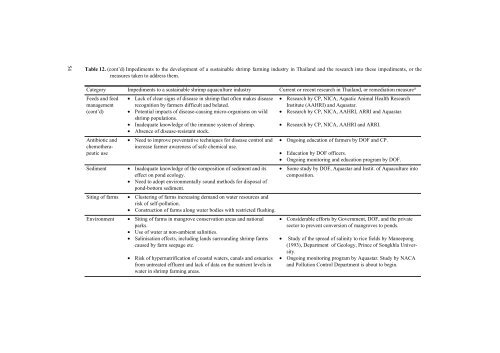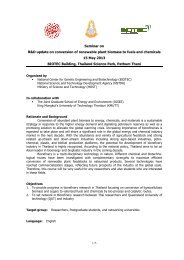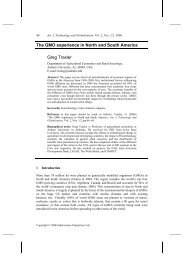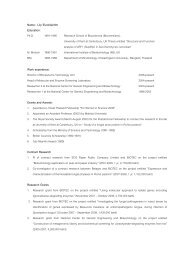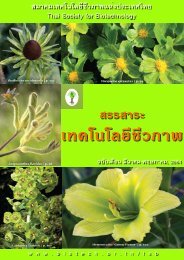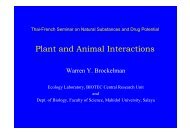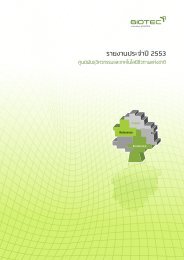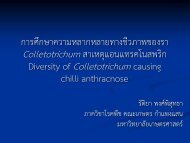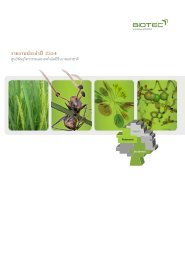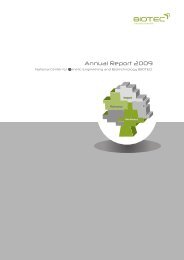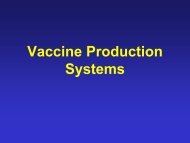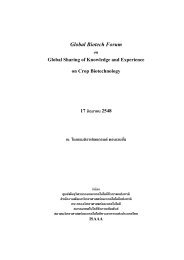Coastal Shrimp Aquaculture in Thailand: Key Issues for Research
Coastal Shrimp Aquaculture in Thailand: Key Issues for Research
Coastal Shrimp Aquaculture in Thailand: Key Issues for Research
You also want an ePaper? Increase the reach of your titles
YUMPU automatically turns print PDFs into web optimized ePapers that Google loves.
$#Table 12. (cont’d) Impediments to the development of a susta<strong>in</strong>able shrimp farm<strong>in</strong>g <strong>in</strong>dustry <strong>in</strong> <strong>Thailand</strong> and the research <strong>in</strong>to these impediments, or themeasures taken to address them.Category Impediments to a susta<strong>in</strong>able shrimp aquaculture <strong>in</strong>dustry Current or recent research <strong>in</strong> <strong>Thailand</strong>, or remediation measure aFeeds and feedmanagement(cont’d)Antibiotic andchemotherapeuticuse% Lack of clear signs of disease <strong>in</strong> shrimp that often makes diseaserecognition by farmers difficult and belated.%! Potential impacts of disease-caus<strong>in</strong>g micro-organisms on wildshrimp populations.% Inadequate knowledge of the immune system of shrimp.% Absence of disease-resistant stock.% Need to improve preventative techniques <strong>for</strong> disease control and<strong>in</strong>crease farmer awareness of safe chemical use.Sediment % Inadequate knowledge of the composition of sediment and itseffect on pond ecology.% Need to adopt environmentally sound methods <strong>for</strong> disposal ofpond-bottom sediment.Sit<strong>in</strong>g of farms % Cluster<strong>in</strong>g of farms <strong>in</strong>creas<strong>in</strong>g demand on water resources andrisk of self-pollution.% Construction of farms along water bodies with restricted flush<strong>in</strong>g.Environment % Sit<strong>in</strong>g of farms <strong>in</strong> mangrove conservation areas and nationalparks.% Use of water at non-ambient sal<strong>in</strong>ities.%! Sal<strong>in</strong>isation effects, <strong>in</strong>clud<strong>in</strong>g lands surround<strong>in</strong>g shrimp farmscaused by farm seepage etc.%! Risk of hypernutrification of coastal waters, canals and estuariesfrom untreated effluent and lack of data on the nutrient levels <strong>in</strong>water <strong>in</strong> shrimp farm<strong>in</strong>g areas.% <strong>Research</strong> by CP, NICA, Aquatic Animal Health <strong>Research</strong>Institute (AAHRI) and Aquastar.% <strong>Research</strong> by CP, NICA, AAHRI, ARRI and Aquastar.% <strong>Research</strong> by CP, NICA, AAHRI and ARRI.% Ongo<strong>in</strong>g education of farmers by DOF and CP.% Education by DOF officers.% Ongo<strong>in</strong>g monitor<strong>in</strong>g and education program by DOF.% Some study by DOF, Aquastar and Instit. of <strong>Aquaculture</strong> <strong>in</strong>tocomposition.% Considerable ef<strong>for</strong>ts by Government, DOF, and the privatesector to prevent conversion of mangroves to ponds.% !Study of the spread of sal<strong>in</strong>ity to rice fields by Maneepong(1993), Department of Geology, Pr<strong>in</strong>ce of Songkhla University.% Ongo<strong>in</strong>g monitor<strong>in</strong>g program by Aquastar. Study by NACAand Pollution Control Department is about to beg<strong>in</strong>.


